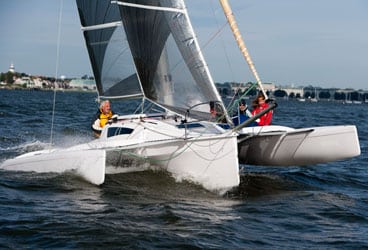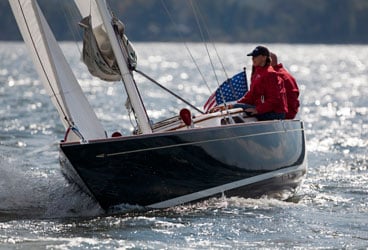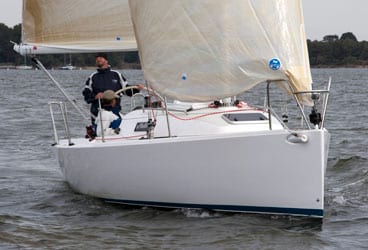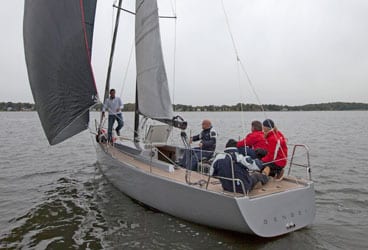Four new boats that last fall were part of Cruising World’s Boat of the Year program illustrate the fact that it doesn’t take a million dollars and a shelf full of maintenance manuals to appreciate a sheer line as sweet as an artist’s brush stroke, a planing hull flying free, or a thin-water cruiser slipping silently through secret waters. The boats are as different as monohulls and trimarans, fixed keels and centerboards, and they were built in America, Vietnam, and Turkey. Yet they all share the same design brief: Keep it simple, make it fun, and provide just enough accommodations to spend a comfortable night or two aboard. As I discovered during test sails on Chesapeake Bay, they all deliver the pure joy of sailing-just in different ways.

Billy Black| |The Corsair Dash 750 was the trailer-friendly speed demon of the group.|
The Corsair Dash 750 trimaran weighs in at a featherlike 1,690 pounds, and since it folds up to a street-legal beam of 8 feet 2 inches, it’s easily towed and stored. Its robust yet simple hinging system for the outer hulls requires only four bolts: Rigging only requires 30 minutes to go from the trailer to skimming over the water.
The Dash 750 could be described as a daysailer, but the pop-top hatch, comfortable inside berths, stove, sink, portable toilet, and 12-volt supply extend its capabilities into the world of sail camping. And its extreme shoal draft and beaching ability make it a great gunkholer.
However, its real raison d’être lies in its blistering speed and fingertip responsiveness. Due to this trimaran’s newly designed high-volume hulls, plum stem, and a generous sail plan operating off a rotating mast, the Dash 750 will match and even exceed most wind speeds. It sails smartly upwind and is absolutely unleashed on a beam reach. An aluminum bowsprit with a roller-furling screacher makes downwind sailing as easy as it’s exhilarating. On my first turn at the helm, I trimmed the sheets and shot off at about 15 knots feeling completely comfortable with the uncomplicated systems.
As the successor to the popular Corsair 24 Mark II, the Dash 750 has a longer waterline, more beam, more volume in the floats, and a taller rig. I expect that a vibrant one-design racing scene will develop around this new model. It’s built in Vietnam with the latest materials and technologies; quality control is closely monitored.

Billy Black| |The M29 is a classic American daysailer from the builder who’s helped define the genre.|
“Art on an anchor” is the best way to describe the Morris line of daysailers. Their achingly beautiful lines beckon us back to a classic time in sailing. But alas, some of the bigger models may be beyond the means of many. However, by scaling the M36 down into the 29-foot M29, Morris has made the gentleman’s daysailer more approachable.
M Series boats seem to satisfy two criteria. First, they must be nothing short of stunning in looks. Second, they must be easy to sail yet fast enough to attract performance sailors. The design by Sparkman & Stephens achieves a fine balance between aesthetics and action here. The narrow hull retains the hallmark S&S look of gracious sheer and overhangs. However, with a displacement of 4,375 pounds, a fin keel, a spade rudder, and a carbon-fiber mast, you can expect some ripping runs.
The hull, constructed of vinylester-infused E-glass, is balsa cored throughout except in areas where deck hardware is fixed. The cockpit is designed along the old-fashioned notion that the benches should be long enough to accommodate a large group of friends or to allow a solo skipper to stretch out while reading a good book.
The cherry-trimmed interior is simple yet attractive and is appropriate for its intended use. Full-length settees run port and starboard. The head has a 10-gallon holding tank. The 12-volt power supply and ample stowage areas are sufficient for weekend cruising.
We test-sailed the M29 in boisterous conditions. I’m embarrassed to admit that I almost tested the limit of positive stability when a blast caught me at the tiller as we were flying a full main and asymmetric spinnaker. However, this little trouper bounced back and held its own with a fine show of speed, both on and off the wind.
I especially liked how all the sail controls cleverly emerge from belowdecks and lead to the helm station. A tiller-extension arm drops into a scallop in the cockpit wall, allowing the boat to steer itself for short periods of time. I did, however, find that the extension interfered with the tiller grip.
The 14-horse Yanmar diesel, a saildrive, and Flexofold propeller powered the boat quickly and quietly. The entire boat is also designed to fit, unstepped mast and all, into a standard shipping container. Thus, from Maine to Miami, easily shipping an M29 makes possible the sailing version of The Endless Summer.

Billy Black| |The J/95’s retractable centerboard and dual rudders make it possible to sail in just 3 feet of water.|
The J/95, off the drawing board of Rod Johnstone, speaks to me, for I’m a backwater man. I love to nip into hidden bays and rivers and slip into foggy marshes to surprise a flock of ducks at dawn. This demands that a vessel have shoal draft and be highly maneuverable and light enough to power off in the event of a grounding.
The J/95 does it all with simplicity, style, and speed. The concept revolves around a beefy keel/centerboard and twin rudders. Johnstone is adamant that one should never rely on a centerboard for a vessel’s inherent stability. So 90 percent of the 2,450-pound ballast sits encapsulated in the keel/centerboard trunk. It draws only 3 feet, but that’s sufficient to protect the saildrive unit and the twin rudders while also providing upwind lift, even with the centerboard fully retracted.
The foil-shaped bronze silicone centerboard drops to 5 feet 6 inches. This increases lateral resistance and enhances, but isn’t a prerequisite for, upwind performance. Traditionally, a drawback to shoal-draft boats is that the shorter rudder loses grip when on the boat is severely heeled. However, with dual offset rudders, the greater the heel, the better the grip of the leeward rudder. Thus I found that on all points of sail, the J/95 answered its helm effortlessly.
The aft-entry cockpit is enormous. Whether you’re carting along a gaggle of grandchildren or making room for a crew of oversized racers, the long benches, ease of access to all sailing functions, and ample yet not domineering wheel make for efficient ergonomics.
The simple interior sleeps four on comfortable cushions. It offers an enclosed head, 12-volt lights, freshwater and black-water tankage, and a picnic cooler. The 5-foot headroom may sound low, but that’s nearly a foot more than its class compatriots. The forepeak is a large and convenient area for stowage.
As to performance, the old saying reminds us that “if it looks like a duck, and quacks like a duck, then it’s a duck.” It looks like a J. It sails like a J. It’s a J! Ample working sail area-492 square feet-drives the boat in a spirited fashion upwind, and be ready to hold on when you unleash nearly 1,200 square feet of downwind sail area.
As easily driven as it is, you won’t need to crank up the 14-horsepower Yanmar and saildrive often, but when you do, the boat provides a good turn of speed and exceptional maneuverability, especially when backing down with those twin rudders. Rod Johnstone was quite excited about his new approach to an old idea. So am I, and so were Boat of the Year judges, who deemed the J/95 Best Weekender and Domestic Boat of the Year.

Billy Black| |The Sensei 9M has the sexy good looks of a performance boat while also being easy to handle.|
The Sensei 9M is designed by Italian Umberto Felci and built by Evraka Marine, near Istanbul, Turkey, to be fast, fun, and family friendly. The simplicity of its running rigging, self-tacking headsail, and tiller steering preclude me from describing it as a racer, but nevertheless, its fine lines, light displacement, and enormous downwind sail area should attract the performance crowd.
The hull is exceptionally light and strong due to carbon-fiber reinforcements and vacuum-infused Corecell and E-glass. This results in a sail area-to-displacement ratio of 22.3 and a “high-performance” feel. A carbon-fiber bowsprit helps the boat carry a big asymmetric spinnaker. This little dart will fly.
All the sheets run under deck cowlings to emerge at the helm station. A notable feature is the unique placement of the winches on the inside of the cockpit seats: They’re cleverly at hand while at the same time eliminating the need to clutter the coamings. This results in a stark yet attractive look that manifests the minimalist spirit of its Japanese name.
The interior is simple, efficient, but perhaps a bit dark due to the fact that there are no ports and only a single opening hatch forward. There’s a full-length berth on both the port and starboard sides. A small V-berth lies behind a short bulkhead in the forepeak.
The hull is European Union CE Category A (ocean) certified and should handle rough water. Still, I feel that the Sensei will find its niche close to shore as a sporty and sexy daysailer.
Each of these boats refocuses our attention on the pure thrill of sailing, whether it’s by means of sublime elegance, breathless performance, or value and versatility. What they share in common is their manageable size; easy-to-handle rigs; generous, social cockpits; and simple systems.
Unlike their larger cruising cousins, they encourage us to just “jump in and go for a spin.” That means more days on the water, and that’s always a good thing.
Alvah Simon is a frequent CW contributor and a veteran Boat of the Year judge.








